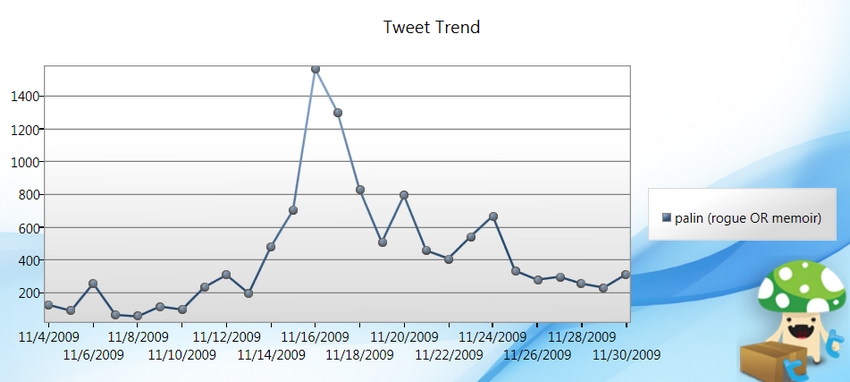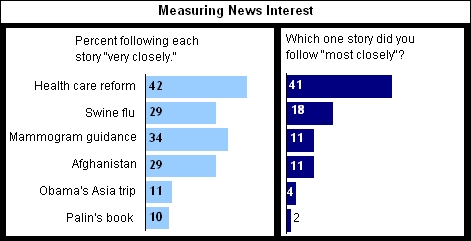
What is one tweet worth?
G. R. Boynton
In How big is big? I looked at relative sizes of the streams of messages about Obama being awarded the Nobel Peace Prize and Oprah announcing her retirement from her afternoon talk show. In both cases there were many tens of thousands of messages; 90 thousand for Obama and 70 thousand for Oprah. We do not know how large those numbers are relative to other microblogging 'hits,' but they are both big personalities attracting lots of attention. And Obama and the political world held its own.
But that does not get us outside the realm of microblogging. It would be nice to look at the volume of a microblogging stream and have some idea about what this meant for a more general public. That is the puzzle for this report even though it looks at only a single case.
Sara Palin published her book about the campaign to lots of press attention. Three hundred thousand books were sold the first day, November 16, 2009, and 450 thousand within a couple of days. She traveled from one televised book signing to another, and we were shown long lines of people waiting for her to autograph their copy of the book. It looked quite a lot like a political campaign swing. That is how it was described by one news organization.
NEW YORK -- Sarah Palin, queen of the Republican right, starred Monday with TV talk queen Oprah Winfrey at the start of a frenzied book tour — and, some believe, an unlikely White House challenge.
The slot on Oprah, which kicked off an unusually high-profile tour for a political memoir, spotlighted Palin's return from the sidelines after her failed run for vice president alongside Sen. John McCain last year and surprise resignation as governor of Alaska. [NewsMax.com]
It also seemed a natural for collecting the stream of messages about an event. The Archivist program searched for twitter messages that included "palin (rogue or memoir)." All the messages found included her name and some included "rogue," some "memoir" and some both. A more complete description of the data collection is available online.
 |
Excerpts from the book made their way into the media before the book was 'officially' released. November 16, 2009 was the date the book went on sale. But there was messaging 'fever' building up on the way to that date. Then on the 16th there were 1500 messages. Since it has been a rather precipitous decline, and it is down to 200 to 300 a day by November 30. By the 30th there had been a total of 11,302 messages about the book.
That is the campaign and the messaging about the book and the campaign. But it does not get to what a broader public would think about the publication and campaign.
The Pew Research Center for the People & the Press does a weekly survey to determine the major stories of interest to the public. And they did one for the relevant week. This is the result of their survey of the adult population of the country.
 |
The news about the publication of Palin's book and the tour was the bottom story for the public. If you take "very closely" it was followed very closely by 10 percent of the respondents. If you take "most closely" it was the news most closely followed by 2 percent of the respondents, which is, statistically not different from zero. But we know it was not zero since there were 11 thousand messages by people who thought this was news worth microblogging about.
Commenting on this Pew study for the Huffington Post, Sam Stein suggested that the difference between media coverage and the interest of the public shows
The findings reflect just how far apart the public and the press are when it comes to news coverage. Certainly there seems to be a greater appetite out there for substantive reporting on health care -- as well as less interest in wall-to-wall Palin coverage -- than conventional wisdom dictates.
He suggests that the media have their own understanding of what sells the news and a salacious wink is very high in the hierarchy of 'newsworthy' events.
One more piece of evidence is worth noticing. Sara Palin resigned as governor of Alaska, and it is possible to look at the twitter responses to that.
In this case the search phrase was Palin but we can assume that much of the microblogging about Palin in November could be captured with the broader search phrase. There was much more microblogging about her resignation than about the book, which is consistent with the Pew results for November. Unfortunately, as the Pew Center says
The latest weekly News Interest Index was in the field when former vice-presidential nominee Sarah Palin made her surprise announcement July 3 that she was stepping down as governor of Alaska. Because that story broke late in the week, it accounted for just 3% of the total newshole, despite heavy coverage during the July 4th weekend.
The survey was already in the field so we cannot compare the microblog to public interest in this case.
So what is one tweet worth? Or what is 11,302 tweets worth? Eleven thousand is not big when compared to the messaging about Oprah and Obama. Perhaps 11,302 tweets is commensurate with the attention of somewhere between 2% and 10% of the public. One might even cautiously note 11 thousand and 10 percent and say 1,000 messages will reflect 1% of interest in the public.
But there needs to be a lot more research before making confident extrapolations. This is just the first piece looking at the puzzle.